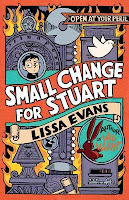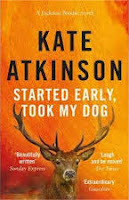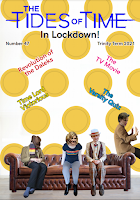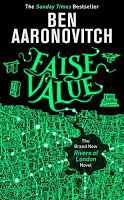Simon Guerrier's Blog, page 37
August 31, 2021
Small Change for Stuart, by Lissa Evans
 Our holiday in north Wales has been enlivened by this brilliant book, written (and, on Audible, read) by Lissa Evans. Stuart is a small-for-his-age 10 year-old who moves house against his will, back to the town where his dad grew up - where there's an age-old family mystery waiting to be solved, if he's the right sort of boy to solve it.
Our holiday in north Wales has been enlivened by this brilliant book, written (and, on Audible, read) by Lissa Evans. Stuart is a small-for-his-age 10 year-old who moves house against his will, back to the town where his dad grew up - where there's an age-old family mystery waiting to be solved, if he's the right sort of boy to solve it.The characters are great - the nosy triplets, the dad who only speaks in long words, the henchman identifiable from some distance by his dove - and the plot is full of twists and jokes and cliffhangers. Every so often we'd work out part of the puzzle just a step ahead of Stuart, making us active participants in the adventure.
An age ago, the great Justin Richards advised me that in constructing a mystery plot, the reader should feel it's all twisty and zig-zag, so they have no idea where it is going; but at the end, when they look back on the route they have come, it should be a dead-straight line. I could see exactly what he meant when I read Dashiell Hammett, and here it is for kids. Exciting, funny, rich - and immensely satisfying.
August 23, 2021
Doctor Who Magazine #568
 The new issue of Doctor Who Magazine is mainly concerned the departures of current Doctor, Jodie Whitaker, and her head writer, Chris Chibnall. Plus there's lots of very interesting stuff from people who remember the now-missing adventures of the First Doctor.
The new issue of Doctor Who Magazine is mainly concerned the departures of current Doctor, Jodie Whitaker, and her head writer, Chris Chibnall. Plus there's lots of very interesting stuff from people who remember the now-missing adventures of the First Doctor.But there's a couple of me bits, too: news that I am producing Doctor Who - the Lost Stories for Big Finish, and the latest Sufficient Data written by me and with the infographic by Ben Morris. This one covers the wealth of animated versions of Doctor Who since 2001. I've just delivered the next one, which is even more spectacularly nerdy...
August 15, 2021
Started Early, Took My Dog, by Kate Atkinson
 The fourth Jackson Brodie novel is another melancholy tale exploring the long shadows cast by murder, grief and loss. There are several interlinking plots: the small child found locked in a flat with his murdered mum in 1975; a former policewoman who was involved in that case now trying to help another child; an elderly actress in the early stages of dementia; Jackson's own investigation on behalf of a client in New Zealand.
The fourth Jackson Brodie novel is another melancholy tale exploring the long shadows cast by murder, grief and loss. There are several interlinking plots: the small child found locked in a flat with his murdered mum in 1975; a former policewoman who was involved in that case now trying to help another child; an elderly actress in the early stages of dementia; Jackson's own investigation on behalf of a client in New Zealand. As in previous books, these plots all turn out to be at least partly connected, or echo one another. In fact, there's quite a lot of doubling: Jackson is dogged by a fellow private investigator with a similar name, and his rescue of a poor, abused dog dovetails with Tracy Waterhouse intervening in the life of a child. As readers, I think we're encouraged to anticipate those connections - and there's a great moment where the gender of a character is revealed, meaning the connection we've made must be wrong.
That makes it sound like this is all densely plotted, but a lot of the book is made up of extended perambulations from one or other character's point of view, picking over their feelings, anxieties and the bits of the past that still haunt them. The result all feels rather loose - at times even a little self-indulgent. Jackson revisits events of previous books, haunted by the murder of his sister when he was very young and by the train crash in the last book, but also going over past relationships from those books - and catching up with at least one of the women in question. James Bond never looks up his exes, but Jackson's past is still a big part of his life.
Among the characters whose eyes we look through is a sexist, racist policeman, complete with his favoured choice of words. Tilly is anxious about unwittingly seeming to be racist. There's a point to this, and I'm sure the author means well yet it struck me that the perspectives that make up the story are all white. Padma (no surname) is a nice, helpful runner on the set of a TV show and John (no surname) is a nice man at the Nigerian embassy, but we only see them from Tilly's point of view, as something other. It's also true of her nice, dead-from-AIDS friend Douglas, the only gay character in the story.
And I'd have liked more from the perspective of the children in the story, not least because they're the real victims of the terrible things that occur. What do they make of the adults interceding on their behalf, the choices made, the results that follow? How do they make sense of what has befallen them? I found some of what happens really upsetting - brutalised, traumatised kids offered help that is at best unconventional. The book ends with the mysteries solved, the questions answered - but surely we know it's not as simple as that. So many grown-ups in the story are haunted by things in the past, why should these kids be any different?
Me on Jackson Brodie:
August 10, 2021
Akira, by Katsuhiro Otomo
 It's 30-odd years since I first read Akira, borrowing each instalment of the beautiful, full-colour run produced by Epic Comics that a schoolfriend's dad was collecting. The six-volume set now available is mostly in black and white (with a few colour pages at the start of each) which, though I know is more authentic, left me a little sad. Yet what a wondrous thing to return to.
It's 30-odd years since I first read Akira, borrowing each instalment of the beautiful, full-colour run produced by Epic Comics that a schoolfriend's dad was collecting. The six-volume set now available is mostly in black and white (with a few colour pages at the start of each) which, though I know is more authentic, left me a little sad. Yet what a wondrous thing to return to.The story is set in Neo-Tokyo in the year 2030, the city rebuilt after World War III. Young, rebellious Kaneda leads a pill-popping biker gang charging through the streets, until his impetuous friend Tetsuo has an accident - crashing his bike rather than colliding with a strange, ancient child who appears from nowhere. The child is Takashi, and he's just one of a number of strange not-quite kids with awesome psychic abilities. When Tetsuo starts to exhibit his own terrifying power, it seems he has a connection to the most powerful not-child of them all, a quiet little boy called Akira...
As well as Kaneda and members of his gang, we follow the stories of various rebels, soldiers, scientists and gurus. There are a lot of characters, and it's a mark of Otomo's skill that they're each so distinct. We can easily recognise characters we last saw more than a hundred pages previously. Oh yes, because this is quite the epic, spanning more than 2,000 pages. It starts big - with the devastation of the war - and then builds and builds and builds.
What struck me reading it again after such a long interval is how much the startling visuals had imbedded in my head - the huge elevator system that descends to the cryogenic storage facility, the ruin of the Olympic stadium, the destruction of the city where skyscrapers rain down from above, and then the ruins emerging from the sea. I've seen the Akira movie several times - recently on Netflix, which prompted this reread. The film is visually amazing and yet it's the comic version that has lodged, for all I only read it once.
I wonder if that's as much to do with the way the images are conveyed as well as what they are. The storytelling is often very visual. Individual panels are full of speed lines and dynamism, but whole spreads can also pass with barely a word spoken, sometimes even no sound effects. What's more, it's all told in dialogue - there is no narration, as in many other comics. Yes, there are some long sequences where information is dumped on us, but on the whole it's concise and immediate. The effect is to no so much read it but soak it in through the eyeballs.
Otomo's clean lines, with slightly cartoony characters in realistic settings, reminds me a lot of Tintin (the look of which was inspired by Japanese comics), and there's a similar mix of serious world politics as setting and daft antics from the lead characters. But this is much more adult - or at least adolescent - stuff. It even steps up in volume 4, with heads exploding, boobs and a willy on show, and a fair amount of swearing. Some of the violence still shocked this world-weary old reader, and the nudity is telling of the way the story is framed. For all Kei is a forthright and able leading character in her own right, we linger on a bathing scene just before she goes to what might be her death, an oddly inappropriate moment for titillation, yet when there's a provident moment to have sex with someone she's really into, there's only a coy kiss. By contrast, the exposed willies are blink-and-you'll-miss-them streaking by random street riff-raff - a willy is for waggling rather than anything else.
Teens reading now will be more struck by the absence of mobile phones and the clunkiness of technology: here, linking to a satellite in orbit takes an amount of time, and the satellite then needs a few moments to track someone's position on Earth. The psychic kids would be astounded by our satnav. But we can hardly blame Otomo for not predicting such things. What's stranger is the technology of his own time not putting in appearance - the street gang apparently have no interest in TV or music, their lives devoid of screens or headphones. I think that's because of the emphasis on them constantly moving.
At the heart of the story are too strong emotions. First, there's the punky defiance of the street gang, battling authority as well as one another. Part of the story is the way that defiance is shaped and focused, to become a force of virtue - and it's quite a feat that we completely get why Kei ends up falling for Kaneda despite him being such a prick. (I don't think we ever learn the fate of the poor girl in volume one who Kaneda has got pregnant and then abandons...)
Second, Akira packs an emotional punch because we understand the strong bonds between the myriad characters. Kei is in love with someone else when she meets Kaneda. Tetsuo battles with Kaneda but craves his friendship. The psychic kids share a strange connection that might just save the world - or end it. When a number of minor characters appear in the closing pages, we understand their allegiances and prospects without having to be told. And then the remaining members of the bike gang mount what remains of their bikes and streak away into the night. I felt a pang at that. How strange, after all the years, to still feel such a connection.
August 9, 2021
Producing Doctor Who
 I'm the new producer of the Doctor Who: Lost Stories range - and Tom Baker's boss, which has been a delight. My masters at Big Finish have announced the two productions I'm currently working on - Doctor Who and the Ark and Daleks! - Genesis of Terror, both for release in March 2023.
I'm the new producer of the Doctor Who: Lost Stories range - and Tom Baker's boss, which has been a delight. My masters at Big Finish have announced the two productions I'm currently working on - Doctor Who and the Ark and Daleks! - Genesis of Terror, both for release in March 2023. As I say in the official announcement:
This is something very special: Doctor Who archaeology brought thrillingly to life. The Ark in Space and Genesis of the Daleks are among the best-loved TV stories ever. We’ve uncovered first draft scripts by John Lucarotti and Terry Nation that are exciting, surprising and very different.”
“Genesis is a very visual script packed with striking, stark images – Nation even makes the stage directions exciting. In Doctor Who and the Ark, the directions were more functional so Jonathan Morris has carefully adapted the script for audio. Though we’ve kept the original episode titles, such as “Puffball” and “Camelias” – I think Tom Baker enjoyed recording those! Oh, and wait till you hear that cliffhanger…
More details to follow in due course, but you can pre-order Doctor Who and the Ark and Daleks! Genesis of Terror right this minute.
August 6, 2021
Directing Doctor Who
 The latest special edition of Doctor Who Magazine is devoted to directing. It includes my interview with Rachel Talalay about directing 2017's Twice Upon a Time. Rachel has spoken at length about her work on Doctor Who - such as to the Radio Free Skaro podcast, in her own instagram posts and now in her YouTube series How I Directed This - but we found some new areas to explore.
The latest special edition of Doctor Who Magazine is devoted to directing. It includes my interview with Rachel Talalay about directing 2017's Twice Upon a Time. Rachel has spoken at length about her work on Doctor Who - such as to the Radio Free Skaro podcast, in her own instagram posts and now in her YouTube series How I Directed This - but we found some new areas to explore.
July 26, 2021
The Tides of Time #47
 The Trinity term issue of
The Tides of Time
, fanzine of the Oxford Doctor Who society features an interview with me conducted by editor James Ashworth, plus reviews of things I've written - Lesser Evils from last year and The Time Travellers from way back in 2005. There are plenty of other things in the whopping 104 pages, not all of them about me. But I am very magnanimous.
The Trinity term issue of
The Tides of Time
, fanzine of the Oxford Doctor Who society features an interview with me conducted by editor James Ashworth, plus reviews of things I've written - Lesser Evils from last year and The Time Travellers from way back in 2005. There are plenty of other things in the whopping 104 pages, not all of them about me. But I am very magnanimous.
July 22, 2021
Doctor Who Magazine #567
 The new issue of Doctor Who Magazine contains, among its many treasures, another "Sufficient Data" infographic by me and illustrator Ben Morris. This one traces the connections between the members of the royal family encountered by various Doctors over the years. Thanks to Simon Belcher for looking over my working.
The new issue of Doctor Who Magazine contains, among its many treasures, another "Sufficient Data" infographic by me and illustrator Ben Morris. This one traces the connections between the members of the royal family encountered by various Doctors over the years. Thanks to Simon Belcher for looking over my working.
July 16, 2021
Influencing the Doctor #51 and #52
 The latest episodes of the Influencing the Doctor podcast feature me being interrogated by host Ethan Gibson on my writing. We cover everything from how I got started and what my influences are, questions about The Time Travellers, Blake's 7 and Graceless, to the stuff I'm up to now -
Scourge of the Cybermen
, my forthcoming Sherlock Holmes novel The Great War and even some vague hints about what I've been doing this week...Influencing the Doctor #51: Simon Guerrier part oneInfluencing the Doctor #52: Simon Guerrier part two
The latest episodes of the Influencing the Doctor podcast feature me being interrogated by host Ethan Gibson on my writing. We cover everything from how I got started and what my influences are, questions about The Time Travellers, Blake's 7 and Graceless, to the stuff I'm up to now -
Scourge of the Cybermen
, my forthcoming Sherlock Holmes novel The Great War and even some vague hints about what I've been doing this week...Influencing the Doctor #51: Simon Guerrier part oneInfluencing the Doctor #52: Simon Guerrier part two
June 29, 2021
False Value, by Ben Aaronovitch
 What a delight to be back in the world of Rivers of London, two years after I read the novella October Man and little more than that since the last novel, Lies Sleeping. This new one starts with the dread prospect that our hero Peter Grant has left the police force and gone into IT - but inevitably things aren't quite what they seem.
What a delight to be back in the world of Rivers of London, two years after I read the novella October Man and little more than that since the last novel, Lies Sleeping. This new one starts with the dread prospect that our hero Peter Grant has left the police force and gone into IT - but inevitably things aren't quite what they seem.The plot involves the threat posed by 3D printing when baddies can make their own guns, and the threat of drones. This is all about IT getting out of hand and taking us into uncharted waters. On top of that, it looks like Peter's new bosses are developing some kind of artificial intelligence...
As usual, what follows is a fast-paced, engaging thriller full of quick wit and telling detail. Peter is surrounded by an ever-growing coterie, as more and more people are brought in on the secret that there is magic in the world. It's a considerable skill to make so many characters distinct and memorable, and despite it being two years since I was last in this story, it's like picking up with good friends - as if no time has passed at all.
Many of the previous books have been part of a larger story which reached something of a conclusion in the last one, so False Value feels refreshingly new and standalone - for all there are threads to be picked up down the line. And how satisfying to finally learn what happened to Nightingale and the other British wizards during the war. Yes, that's the very word right there. The book is exciting, smart and fun, perfectly executed to leave the reader sated.
Simon Guerrier's Blog
- Simon Guerrier's profile
- 60 followers



